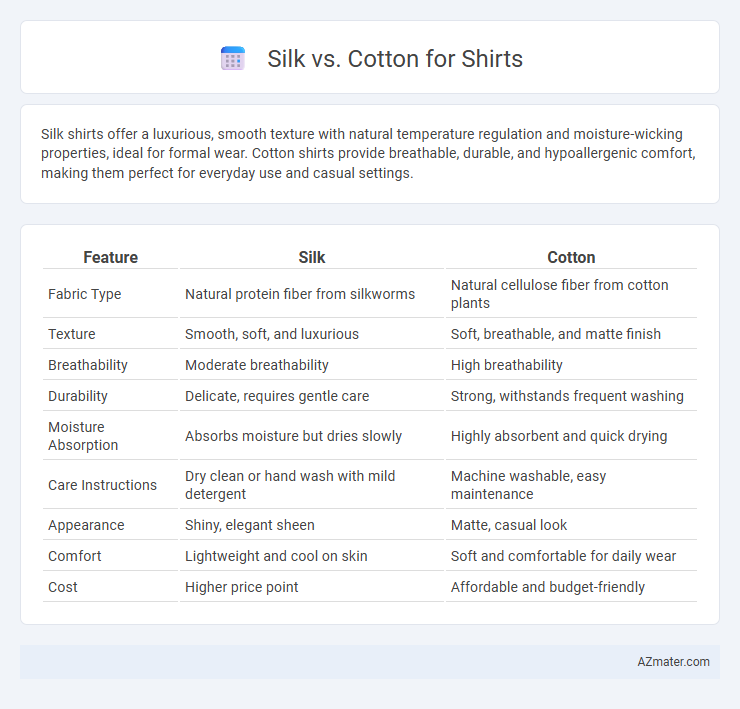Silk shirts offer a luxurious, smooth texture with natural temperature regulation and moisture-wicking properties, ideal for formal wear. Cotton shirts provide breathable, durable, and hypoallergenic comfort, making them perfect for everyday use and casual settings.
Table of Comparison
| Feature | Silk | Cotton |
|---|---|---|
| Fabric Type | Natural protein fiber from silkworms | Natural cellulose fiber from cotton plants |
| Texture | Smooth, soft, and luxurious | Soft, breathable, and matte finish |
| Breathability | Moderate breathability | High breathability |
| Durability | Delicate, requires gentle care | Strong, withstands frequent washing |
| Moisture Absorption | Absorbs moisture but dries slowly | Highly absorbent and quick drying |
| Care Instructions | Dry clean or hand wash with mild detergent | Machine washable, easy maintenance |
| Appearance | Shiny, elegant sheen | Matte, casual look |
| Comfort | Lightweight and cool on skin | Soft and comfortable for daily wear |
| Cost | Higher price point | Affordable and budget-friendly |
Introduction: Silk vs Cotton Shirts
Silk shirts offer a luxurious, smooth texture with natural sheen and excellent breathability, making them ideal for formal occasions and comfort in warm weather. Cotton shirts provide durability, moisture absorption, and ease of care, favored for everyday wear and casual styles. Both fabrics present distinct benefits in softness, temperature regulation, and maintenance, influencing style, comfort, and garment longevity.
Fiber Origins and Characteristics
Silk fibers originate from silkworm cocoons and are prized for their natural sheen, smooth texture, and excellent moisture-wicking properties. Cotton fibers come from the seed hairs of the cotton plant and are valued for their breathability, durability, and softness. Both fibers offer unique benefits: silk provides a luxurious feel and temperature regulation, while cotton ensures comfort and easy care for everyday wear.
Texture and Comfort Comparison
Silk shirts offer a smooth, luxurious texture that feels cool and gentle against the skin, making them ideal for formal wear and sensitive skin. Cotton shirts provide a soft, breathable texture with excellent moisture absorption, ensuring comfort in warm or active conditions. The natural fibers in cotton enhance airflow, while silk's natural protein structure results in a glossy finish and lightweight comfort.
Breathability and Moisture Management
Silk shirts offer moderate breathability and natural moisture-wicking properties, making them suitable for light, dry conditions but less effective in heavy sweating. Cotton excels in breathability due to its porous fibers, allowing optimal airflow and superior moisture absorption that keeps the skin dry and comfortable. For high-activity or hot climates, cotton provides better moisture management and temperature regulation compared to the delicate, less absorbent silk fabric.
Durability and Longevity
Silk shirts offer a luxurious feel but tend to be less durable than cotton due to their delicate natural fibers, which can weaken and tear with frequent wear or improper care. Cotton shirts are known for their high durability and longevity, making them ideal for everyday use, as they withstand repeated washing and abrasion without significant damage. Choosing cotton ensures sustained fabric strength and color retention over time, while silk requires careful handling to maintain its quality and lifespan.
Care and Maintenance Requirements
Silk shirts require gentle care, including hand washing with mild detergent or dry cleaning, to maintain their smooth texture and prevent damage from harsh chemicals or high heat. Cotton shirts are more durable and can withstand regular machine washing and higher temperatures, though frequent washing may cause shrinkage or fading over time. Storing silk in a cool, dry place away from direct sunlight prevents discoloration, while cotton's robust nature allows for easier, less delicate storage conditions.
Elegance and Visual Appeal
Silk shirts exude unmatched elegance with their natural sheen and smooth texture, creating a luxurious visual appeal that enhances any outfit. Cotton shirts offer a crisp, clean look with a matte finish, providing versatility and comfort while maintaining a polished appearance. The luminous quality of silk makes it ideal for formal occasions, whereas cotton's breathable fabric suits both casual and semi-formal styles.
Eco-Friendliness and Sustainability
Silk production involves mulberry cultivation and silkworm farming, which require significant water and labor inputs but are biodegradable and renewable, making it relatively eco-friendly compared to synthetic fibers. Cotton, especially organic cotton, uses less water and fewer pesticides than conventional cotton, supporting soil health and biodiversity, though it demands larger land areas for cultivation. Choosing between silk and cotton for eco-friendly shirts depends on prioritizing water conservation and chemical use versus land use and biodegradability.
Price and Value Considerations
Silk shirts typically command higher prices due to the labor-intensive production process and luxurious texture, making them a premium investment for special occasions. Cotton shirts offer greater affordability and durability, providing excellent value for everyday wear and frequent laundering. When choosing between silk and cotton, consider your budget, intended use, and long-term cost efficiency to maximize the value of your purchase.
Choosing the Right Fabric for Your Needs
Silk offers a luxurious, smooth texture with natural temperature-regulating properties, making it ideal for formal occasions and lightweight comfort in warm weather. Cotton provides breathability, durability, and ease of care, perfect for everyday wear and those with sensitive skin or allergies. Selecting the right fabric depends on your lifestyle needs, whether prioritizing elegance and softness or practicality and maintenance.

Infographic: Silk vs Cotton for Shirt
 azmater.com
azmater.com